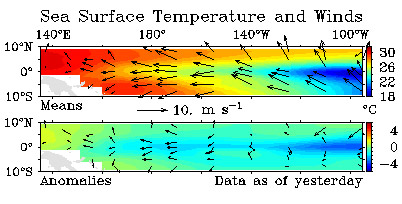
La Niña ocean temperatures from NOAA. What happens down there changes the weather up here.
Atmospheric gurus (otherwise known as meteorologists) look to the Equatorial Pacific Ocean for help with their long range forecasting. When the ocean in that area gets colder than normal it’s known as La Niña (the girl child); when warmer it is El Niño. This winter, the little girl will rule. So what will that bring us in terms of backcountry skiing?
The guru who made our Denali trip a total success, Joel Gratz, comes up with interesting answers. In a Boulder Daily Camera newspaper article, he says during La Niña the PNW and perhaps northern U.S. interior areas such as Montana will get pounded. Indeed, he points out, during the 98/99 Niña season was when Mount Baker got the most snow ever recorded in a single season in the United States. I remember that winter, and the stories of how they had to dig out the Baker chairlift towers before they could start the ski lifts.
As for our neighbors up north, my research indicates B.C. areas such as Whistler and Fernie may be favored. Should we get a visit to Bellingham on the book? Probably.
Farther south, say around New Mexico and So Cal, Joel says La Niña can make things dryer. In my reading, I’ve even seen the word “drought” crop up in relation to those areas and their influence from La Niña.
As for us here in Colorado, Joel says we’re in the middle of the trends so our northern mountains might get more snow, and southern ranges such as the San Juans may get less. Our home base is in the central Colorado zone, north of the ‘Juans and south of other stuff, so it is total mystery what’ll happen here. Most years we get just enough snow to keep us going, so just a few big storms can tip us up to the excellent zone — or a few missed storms can drag us into the depths, meaning deep in depth hoar avalanches.
One thing I’m curious about is if La Niña will change the number or intensity of dust storms we get here in Colorado. These “snirt” (snow dirt) events essentially ruin our snowpack for the quality spring skiing Colorado has been known for over the years, and look to have been increasing in frequency and most certainly in severity. Joel says more wind will blow along the Continental Divide due to La Niña, but that’s not what’s causing the evil snirt. Indeed, from what I’ve seen at least some of those dust storms arise from the Four Corners area, and are obviously the result of unstable soil caused by who knows what, but for which drought must play a part. Thus, one could infer that if the little La La exacerbates drought conditions down there, the dang dust storms will continue (and could worsen).
If you’re interested in our dust issue, check out The Center for Snow and Avalanche Studies.
Joel’s long range forecast for Colorado is here.
WildSnow.com publisher emeritus and founder Lou (Louis Dawson) has a 50+ years career in climbing, backcountry skiing and ski mountaineering. He was the first person in history to ski down all 54 Colorado 14,000-foot peaks, has authored numerous books about about backcountry skiing, and has skied from the summit of Denali in Alaska, North America’s highest mountain.
